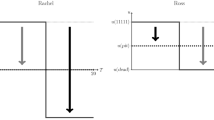Abstract
It has been shown which assumptions are reasonable to combine quality of life with length of life, those attributes fundamental to the quality-adjusted life-year concept. One of these assumptions is the so-called “constant proportional tradeoff” which restricts the underlying utility functions for life-years to those consistent with constant proportional risk posture. However, this might be too restrictive because “constant absolute tradeoff” cannot be reflected. Pliskin et al. mentioned this case already and suggested an exponential function as a proper function to reflect the underlying constant absolute risk posture. Its proof is given in the appendix of this article. A survey among tinnitus patients, however, shows that this assumption is less plausible. Further research is needed to confirm that finding.

Similar content being viewed by others
References
Cher DJ, Miyamoto J, Lenert LA (1997) Incorporating risk attitude into Markov-process decision models: importance for individual decision making. Med Decis Making 17:340–350
Feldmann H (1998) Tinnitus: grundlagen einer rationalen Diagnostik und Therapie. Thieme, Stuttgart
Gafni A, Torrance GW (1984) Risk attitude and time preference in health. Manage Sci 30:440–451
Garber AM, Weinstein MC, Torrance GW, Kamlet MS (1996) Theoretical foundations of cost-effectiveness analysis. In: Gold MR, Siegel JE, Russell LB, Weinstein MC (rds) Cost-effectiveness in health and medicine. Oxford University Press, New York, pp 25–53
Keeney RL (1982) Decisions analysis: an overview. Operations Res 30:803–838
Keeney RL, Raiffa H (1976) Decisions with multiple objectives: preferences and value tradeoffs. Wiley, New York
Pliskin JS, Shepard DS, Weinstein MC (1980) Utility functions for life years and health status. Operations Res 28:206–224
Pratt JW (1964) Risk aversion in the small and in the large. Econometrica 32:122–136
Smidts A (1997) The relationship between risk attitude and strength of preference: a test of intrinsic risk attitude. Manage Sci 43:357–370
Verhoef LCG, de Haan AFJ, van Daal WAJ (1994) Risk attitude in gambles with years of life: empirical support for prospect theory. Med Decis Making 14:194–200
Author information
Authors and Affiliations
Corresponding author
Additional information
An erratum to this article can be found at http://dx.doi.org/10.1007/s10198-004-0231-8
Appendix: Proof
Appendix: Proof
Firstly, the existence of a constant absolute risk posture functional form 1−e −λ·y is shown, which is consistent with the constant absolute tradeoff assumption. If q * and q* denote the lowest and highest health status levels, respectively, with its utilities set to 0 and 1 for convenience, the constant absolute tradeoff assumption states that:
for all p>0 and for all γ>p. Substituting (y,q *) and (y−p,q*) into Eq. 1, recalling that U Q (q *)=0 and U Q (q*)=1, and equating the two utilities thus obtained, we find that:
If U y (y)=1 −e −λ· for a risk averse individual (λ describes the degree of aversion; this representation restricts utilities between 0 and 1 for convenience. Von Neumann-Morgenstern utilities are unique up to a linear transformation) follows, with some algebra, in Eq. 2:
For the equality to hold, one condition (among others) for parameter a and b can be:
Therefore parameter a (Eq. 4) and b [Eq. 5, with 0≤b<1] are consistent with Eq. 2 [7]. It has been shown that functional forms with constant absolute risk posture exist which are consistent with the constant absolute tradeoff assumption when two particular health states q * and q* are involved in the tradeoffs. It remains to be shown that the utility functions with constant absolute risk posture are the only ones consistent with the constant absolute tradeoff assumption. The function for the constant absolute risk posture is:
If one differentiates Eq. 2 twice and divides the second derivative of each side by the first derivative gives:
Expressed with the risk posture function:
Since this equation holds for all 0<p<γ and for all γ≥0, i.e., the risk posture function is independent of the argument of the function, R Y (y)=const., can be concluded. Thus, Uy(y) exhibits constant absolute risk posture.
Rights and permissions
About this article
Cite this article
Happich, M., Muehlbacher, A. An exponential representation of health state utility. HEPAC 4, 292–294 (2003). https://doi.org/10.1007/s10198-003-0186-1
Issue Date:
DOI: https://doi.org/10.1007/s10198-003-0186-1




